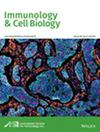Unraveling the origins of pathogenic CXCL13+ helper T cells in systemic lupus erythematosus
IF 3
4区 医学
Q3 CELL BIOLOGY
引用次数: 0
Abstract
This Research Highlight discusses a recent publication, where the authors identified an increase in CXCL13+ peripheral helper T/follicular helper T cells, which was concomitant with a decrease in CD96+ T helper 22 (TH22) cells in patients with systemic lupus erythematosus. The genetic and epigenetic cues that reciprocally regulate this pathogenic imbalance of T-cell subsets were also identified, thus providing targets for therapeutic intervention.

揭示系统性红斑狼疮中致病性 CXCL13+ 辅助 T 细胞的起源。
本研究亮点讨论了最近发表的一篇论文,作者在该论文中发现,在系统性红斑狼疮患者中,CXCL13+外周辅助性T细胞/滤泡辅助性T细胞增加的同时,CD96+ T辅助性22(TH22)细胞减少。此外,还确定了相互调控这种致病性 T 细胞亚群失衡的遗传和表观遗传线索,从而为治疗干预提供了靶点。
本文章由计算机程序翻译,如有差异,请以英文原文为准。
求助全文
约1分钟内获得全文
求助全文
来源期刊

Immunology & Cell Biology
医学-免疫学
CiteScore
7.50
自引率
2.50%
发文量
98
审稿时长
4-8 weeks
期刊介绍:
The Australasian Society for Immunology Incorporated (ASI) was created by the amalgamation in 1991 of the Australian Society for Immunology, formed in 1970, and the New Zealand Society for Immunology, formed in 1975. The aim of the Society is to encourage and support the discipline of immunology in the Australasian region. It is a broadly based Society, embracing clinical and experimental, cellular and molecular immunology in humans and animals. The Society provides a network for the exchange of information and for collaboration within Australia, New Zealand and overseas. ASI members have been prominent in advancing biological and medical research worldwide. We seek to encourage the study of immunology in Australia and New Zealand and are active in introducing young scientists to the discipline.
 求助内容:
求助内容: 应助结果提醒方式:
应助结果提醒方式:


